15 SEO Tips for Financial Services & Finance Professionals

Scarlett Pirie

Are you a financial service provider or professional looking to improve SEO on your website, but not sure where to start?
In this article, I’ve broken down 15 essential SEO tips for any website in the finance sector looking to rank better on Google, specific to the finance industry. Mastering these 15 steps is a great way to get your organic marketing off the ground for any finance professional. As always, links to further reading are provided in the article, but please feel free to reach out if you are looking for further support.
1. Conduct keyword research
For any successful SEO strategy in any industry, keyword research is an essential type of research that will feed into all other SEO considerations. Keyword research is essentially the process of compiling search terms that people make on Google or other search engines specific to your industry, and how frequently those searches are being made.
When you gain an understanding of what people are searching for, you can make sure you produce and optimise content specifically for your audience. This is the cornerstone of any SEO strategy for financial service providers.
Popular keyword research tools include Ahrefs, Semrush, Moz, Mangools and Google Keyword Planner.
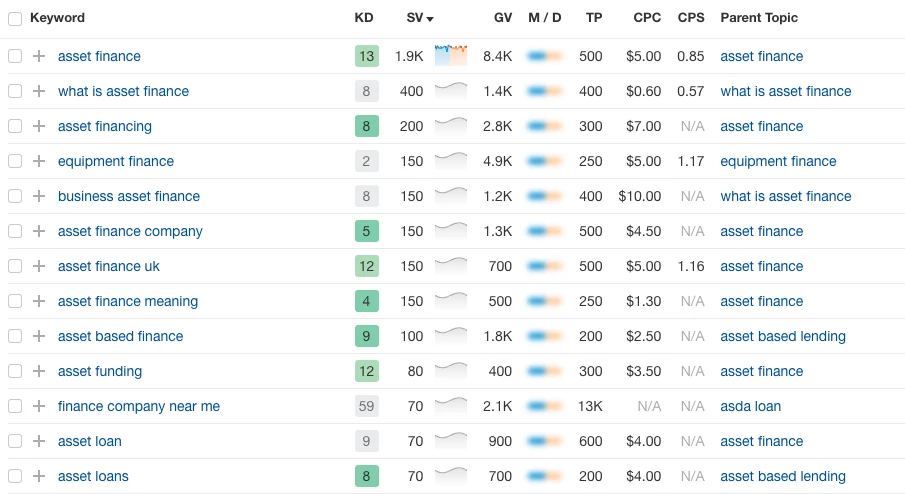
When you conduct keyword research, you can see the different search intents of your audience. In the example above, you can see "what is asset finance", a search someone might make when they are looking for information (usually an article). By contrast, "finance company near me" would seem to come from a user searching for a local finance company.
Further reading suggestion: Keyword research basics for Financial Services SEO
2. Understand YMYL
For businesses operating in the finance industry, understanding what YMYL is is essential to successful SEO. YMYL stands for “Your Money or Your Life” and refers to topics that could significantly impact individuals lives and, if misinformation is spread, could have significant repercussions. Known YMYL sectors include:
Medical
Finance
Current Events

As a financial service or professional, you have a greater responsibility for ensuring any content on your website is accurate and demonstrating why and how you are qualified to offer advice on topics in the financial sector.
To do this, you must consider what is known as EEAT (Expertise, Experience, Authority and Trust), something that is outlined in Google’s Search Quality Rater Guidelines (QRG).
As an operator in this market, it is worth reading up on Google’s guidelines on YMYL and EEAT as well as this Semrush article on YMYL and EEAT as understanding these concepts in detail can help you execute a better marketing strategy. In the next section, I'll explain a bit more about EEAT.
3. Optimise for E-E-A-T
As mentioned above, EEAT stands for Expertise, Experience, Authority and Trust.
In order to ensure your financial services website meets EEAT standards for YMYL, I have a few tips and suggestions:
Create high quality content: All pages on your finance website should be thorough, accurate and high quality. This helps strengthen credibility and trust in your website, as clear effort and knowledge has been invested in your webpages.
Use and link to sources: If you are making claims on your website, make sure to back them up with sources or links to relevant websites. For example, if you are writing about annual consumer credit returns, linking to the relevant FCA pages can help validate the information you are providing.
Link to Social Networks: If you have social media pages, such as LinkedIn or Twitter, make sure these are linked to from your website. Social links can help furhter solidify your credibility and the trustworthiness of your website.
Use Authorship: When publishing articles, being transparent about who the author is and what makes them qualified to write about such topics can help showcase expertise and authority. Below is a good example of this from DRIVA:

4. Set up analytics tracking
Having an analytics solution setup is essential for finance professionals who want to understand how well their website is performing. With analytics tracking in place, you can see how many users are visiting your website, which pages they are landing on and where they came from (e.g. from Google, Bing, direct etc.)
Some popular solutions include Google Analytics, Adobe Analytics, Fathom and Unami.
5. Consider Local SEO
If you are a finance provider providing financial services to clients in your local area, local SEO is essential to consider. Particularly if you have customers visiting you at your office or business address, making yourself more visible in local search is a big consideration for finance professionals.
For local SEO, ensure that you set up a Google Business Profile if you have a business location from which you operate and see clients or customers. This allows customers to find you on Google Maps as well as leave you public reviews which can be great for EEAT.
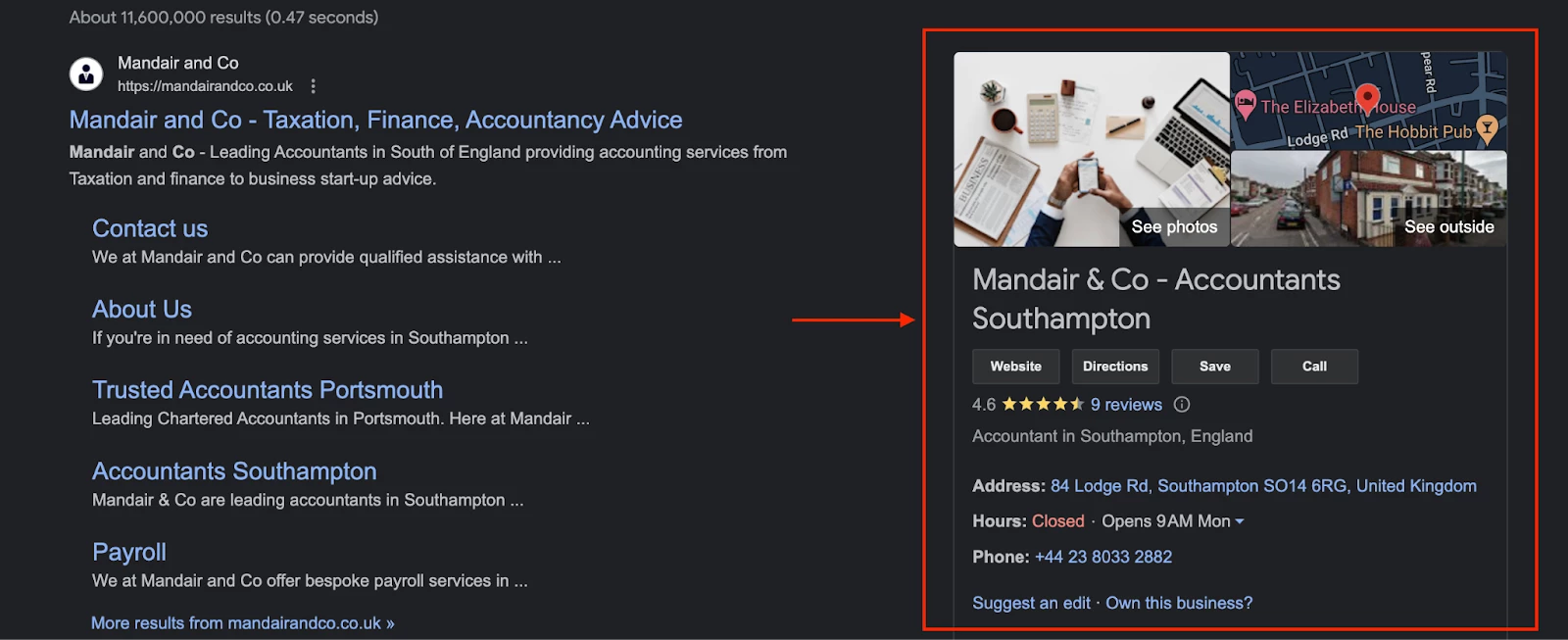
In addition, ensure that anywhere you are locally listed, such as in local directories, has up to date and accurate business information. Google uses NAP (Name, Address, Postcode) data to ensure you’re actually located where your website says you’re located, which helps you appear in local search. The more places you are locally listed, the stronger those signals can be.
6. Write expert financial content
As an expert in the financial sector, you are well placed to offer expert advice in the form of blogs, guides or articles. This is important as not only can expert content such as this help drive more traffic, it also helps establish you as an authority in the finance industry which helps build the topical relevancy of your website. Thus, helping improve SEO.
Expert financial content can vary depending on the specific financial service you offer. For example, a finance broker will have different knowledge to an accountant. It’s best to conduct your own keyword research for your specific financial services in order to understand the sorts of topics your potential customers may be looking for answers to.
Here are some great examples of expert financial content:
Remember, any content you publish should be backed up with E-E-A-T signals to signal to users and Google that your content is trustworthy. Include information such as:
Author name (a first and last name help to indicate the author is a real person)
Author biography (what makes the writer qualified to give out financial advice?)
Author job title (helps to solidify that the author is qualified to offer financial advice)
Sources (link to any additional information sources to validate what is being said)
7. Implement optimised Meta Titles & Descriptions
Meta tags are HTML tags that are used to provide additional contextual information to search engines and browsers. You can use these tags to provide information about the title and description of your finance website pages.
For each page on your website, particularly those you would like to perform well in search, make sure to implement optimised meta tags.
Title Tag
This is an important ranking factor and should be optimised for your target keywords on every page. Title tags should be around 50-60 characters.
For example: <title>Event Equipment Finance | Lighting, Sound & Outdoor Gear</title>
Title tags, when well optimised, can be pulled through onto search engine results pages when you appear, such as below:
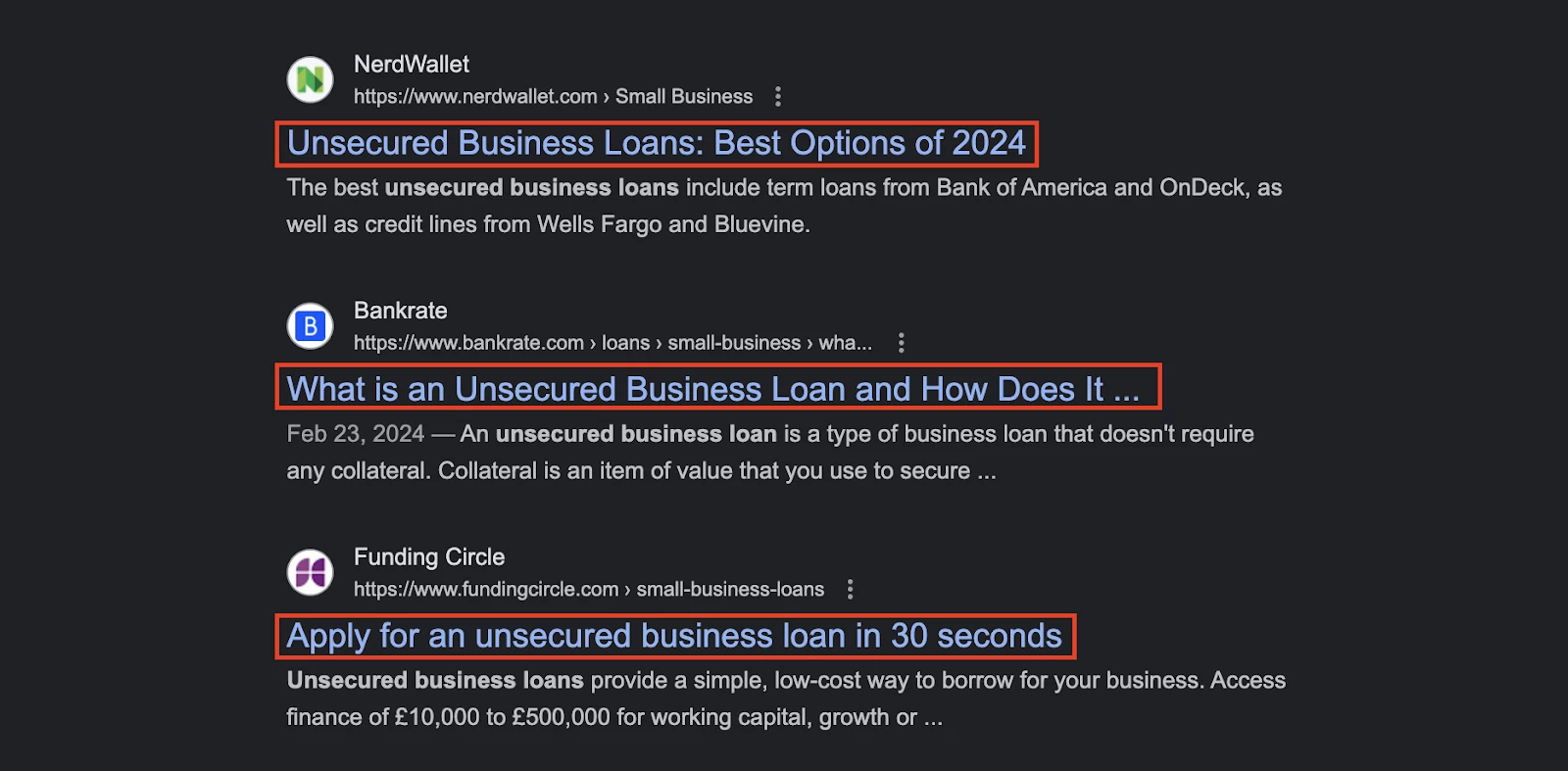
Description Tag
Descriptions are not a ranking factors but can be beneficial for CTR (Click Through Rate) from Google to your website. An optimal description tag should be between 150-160 characters.
For example: "Whatever the event, we offer finance for event equipment including outdoor cinemas, audio visual equipment, mobile stages and much more."
8. Add H1s and relevant subheadings to your pages
H1 tags are used to indicate the primary purpose of the content of your webpage, just as you would add a title to an article, document or email. H tags can be ordered hierarchically from H1 to H6 and they can indicate the most and least important sections of your content.
An H1 tag is implemented in HTML and should be wrapped around your main page title. This is a great way to indicate to Google and readers what the primary purpose of your page is and, where relevant, optimise this for your main keywords for SEO.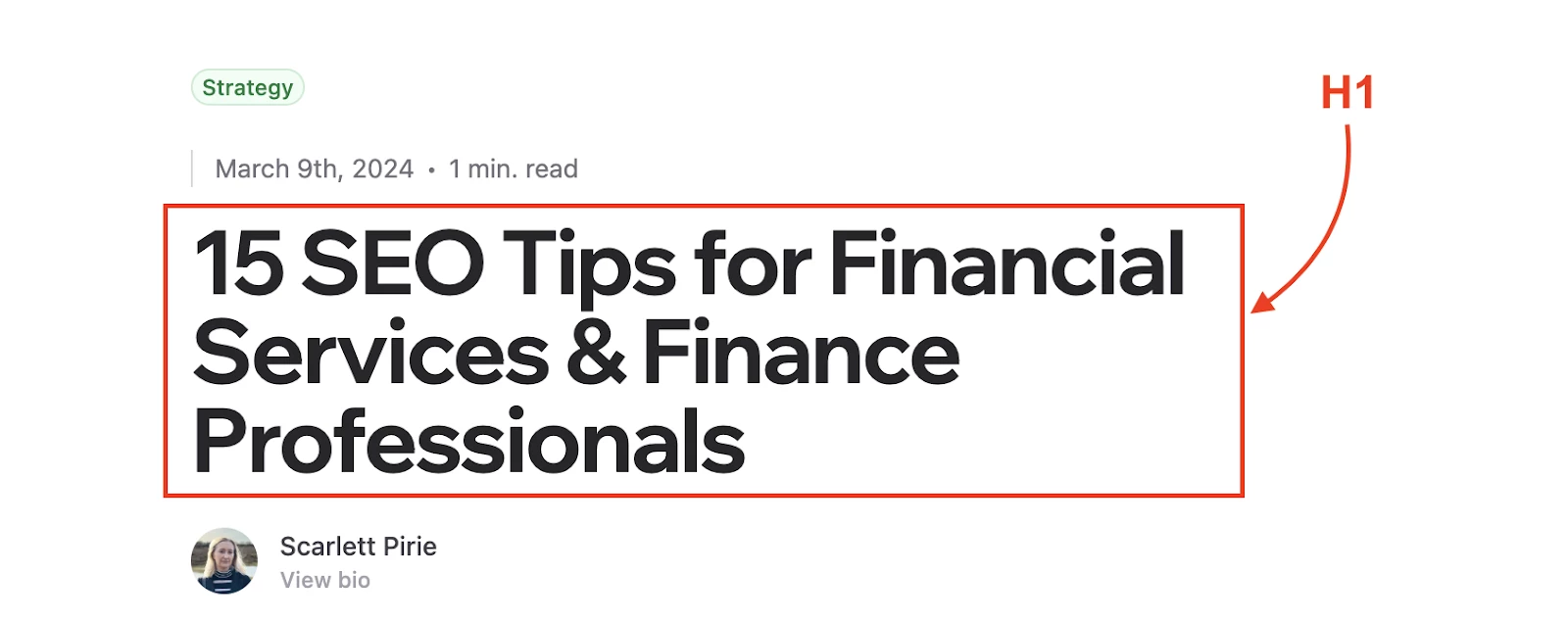
Further reading suggestion: What is an H1 tag?
9. Utilise Google Search Console
Google Search Console is another tracking tool that you should have set up on your finance website if you want to track your SEO. GSC provides helpful information that analytics tools don’t tend to provide. This includes data such as which keywords are generating clicks to your website.
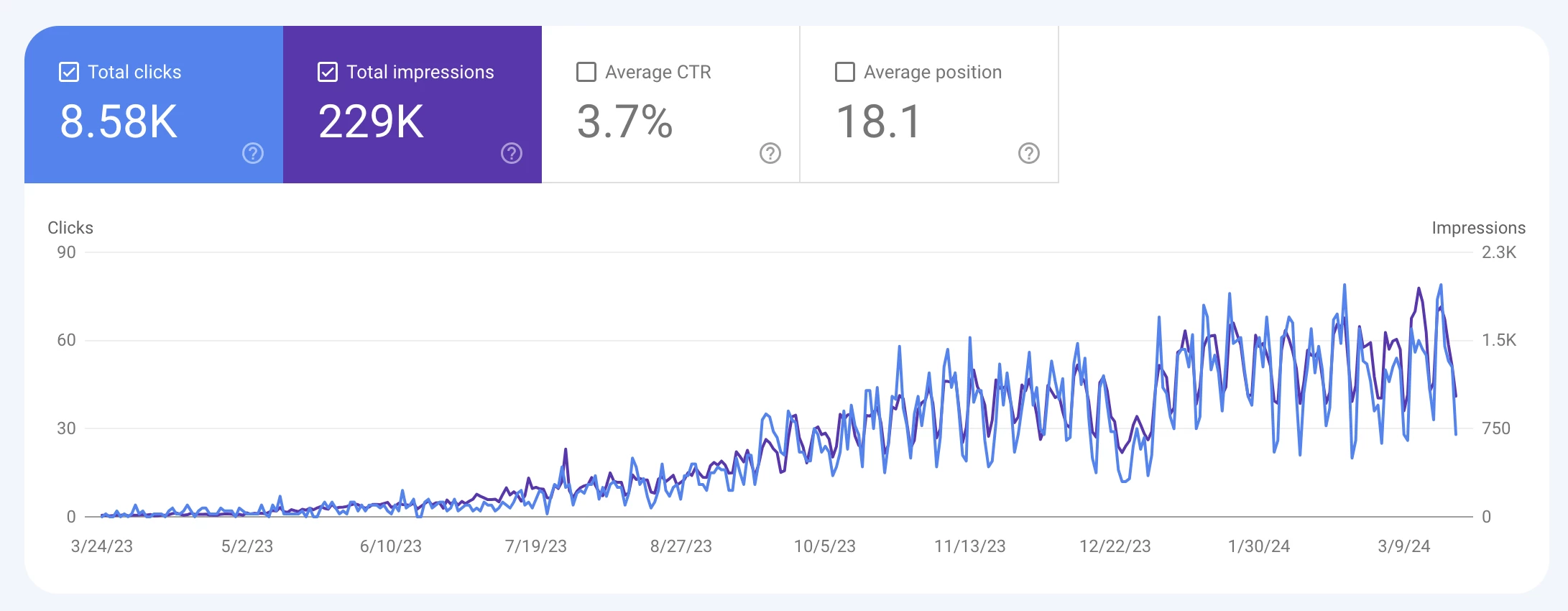
GSC also provides essential technical information, such as if any of your pages have indexing errors, security errors and core web vitals reporting. I recommend reading up on Google’s documentation for Google Search Console to get familiar with the tools it offers and how you can use it. Or, feel free to pop me a message if you’re looking for a bit of extra help.
Bing also provides Bing Webmaster Tools.
10. Make sure your website is mobile friendly
Did you know that 58% of mobile searches come from mobile devices?
Paying close attention to mobile experiences is important. While many B2B finance customers often come from desktop (laptops or computers), mobile is still very much used in the B2C sector and across the board. Therefore, having a good mobile experience can be essential, not only for customers, but also for Google. Google takes a mobile-first approach to indexing, and I recommend reading Google’s guidelines on mobile best practices for your finance website.
11. Check your page speed
We all know the feeling of visiting a website that takes forever to load. If you want people to stay on your website, and want Google to rank your website on search, making sure your website is fast for users on both computers and mobile devices is an essential part of SEO efforts on your financial services website.
Using PageSpeed Insights and Google Search Console, you can test the speed of your website and know if your finance website passes or fails their speed test, both on desktop and mobile.
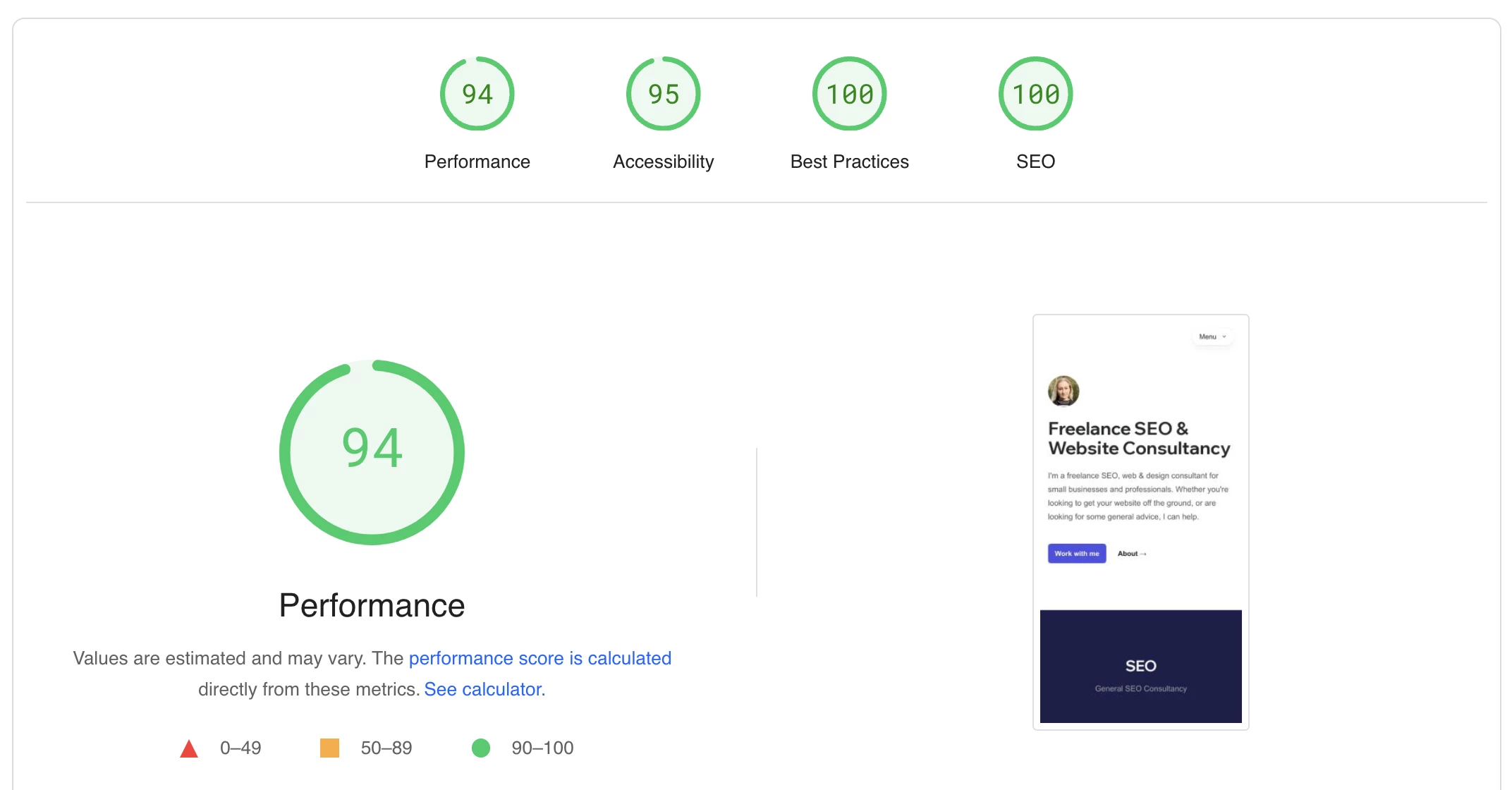
Further reading suggestion: Tips to improve website speed
12. Make sure your website is secure
Ever visited a website and seen that little popup that says your connection is not private?
Well, Google and other search engines can see that too. Security is a consideration for your finance website as Google does not want to serve insecure results to its users, and in 2014, Google announced that HTTPS is a ranking signal.
This means you need an SSL certificate on your website so that users' privacy is secure and they can connect to your site securely. This is usually handled by whoever your hosting provider is, so it’s best to speak to them or your IT team to ensure this is setup correctly.
13. Implement relevant structured data
Another consideration for your financial services website is something known as Schema or Structured Data. This is a type of code that can be added to your webpages to help search engines better understand your content.
It can also make you eligible for Rich Results - essentially helping you stand out in search results. This can make users more likely to notice you and click through to your website. Below, you can see and example of where Review schema is being pulled through and showing a star rating:

Some schema types I would recommend for businesses in the finance industry include:
Organization or LocalBusiness: This schema allows you to provide more information about your finance company, such as the name of your company, address, contact information and opening hours. Google can use this to enhance results that contain your company information.
Review: If you collect reviews on your website from your customers, you can use Review schema and be eligible for a star rating like the example above on Google.
I recommend reading Ahrefs’ article on Schema for more information on how to add it to your website.
14. Optimise your images
Images are a great way to sell your brand on your website. Financial services can be a fairly difficult industry to visually showcase given the nature of the industry, but the use of stock imagery is perfectly fine and can still help enhance the readability of your website.
If you are using images for your financial services website, make sure they are optimised for SEO.
Image file sizes: Ensure your images are compressed to an optimal size to reduce the amount of time your webpages take to load. Take a read of Yoast’s helpful article on image optimisation.
Alt text: Alt text provides image descriptions to search engine crawlers, helping them to index and rank an image properly in image search. It is also used for accessibly purposes, so optimising this is also an SEO consideration.
15. Implement optimised link architecture
Last but certainly not least, internal linking. This one is a pivotal part of ensuring SEO success for your finance website. Link architecture essentially refers to internal linking on your website and is used by Google to understand important pages on your website.
"Link architecture [is] a crucial step in site design if you want your site indexed by search engines. It plays a critical role in Googlebot's ability to find your site's pages and ensures that your visitors can navigate and enjoy your site.”
Here are my top tips for internal linking on your financial services website:
Ensure your most important pages are within a few clicks from the homepage: This may include pages like your services pages, information about your financial services or your contact page.
Make sure links can be crawled by Google: Use proper
<a>tags and avoid usingrel=”nofollow”Create intuitive navigation for users: Make sure your customers can easily navigate through your site from the main menu.
Use optimised anchor text: Using descriptive hyperlinks (such as “Explore Car Finance” instead of “Learn More”) can help Google better understand your content and see how pages link together.
Building a Successful SEO Strategy for Finance
By following the 15 tips above, you can be well on the way to a successful SEO strategy, whether you are a finance broker, financial advisor or provide a range of financial services. Understanding and mastering each of the above can put you on the right path to gaining an advantage over other competitors in your niche.
The finance sector is vast and ever changing. Having worked with businesses in this dynamic industry, I know that having the right SEO strategy in place can be pivotal to online success. I hope you have found this article helpful, and if you are looking for further SEO support, please feel free to get in touch.
